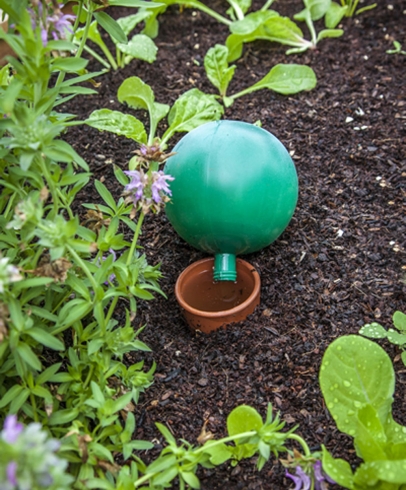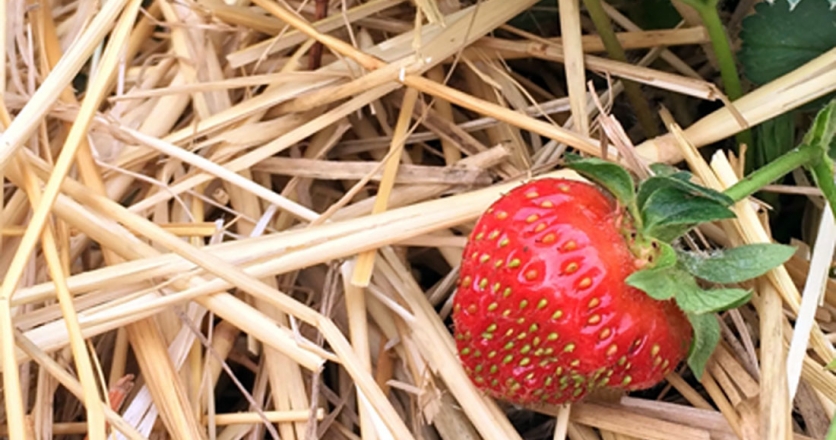Create a Water-Efficient Food Garden
More Food, Less Water
I am highly water conscious. Aside from living in Guelph, which relies on a finite groundwater supply, I'm aware that while many people struggle for access to drinkable water, we think nothing of flushing it down our toilets, washing our cars with it, and wasting it on our lawns.
In Canada—and Ontario, in particular—we have an abundance of freshwater in big lakes, which makes the supply seem endless. It isn't, however, or at least not if we want our children's grandchildren (and so on) to have freshwater, too. And now even the California drought has me concerned.
Late last year I bought a small house with a large yard. I wanted the outdoor space because I love being outside and I want to have lots of trees and plants. I never water my lawn, so I'm choosing drought tolerant, mostly native plants for my decorative gardens. But what about my food garden?
I love growing my own food. In the past I've done this in community gardens, but now that I have space of my own I want to go beyond the rain barrel and work on creating a truly water–efficient fruit and vegetable garden.
Guelph has no watering restrictions on food gardens. In fact, the city separated food-garden watering as a unique use under the City's outside water-use bylaw. There are restrictions on lawn watering at all times and on decorative gardens during drought, but never on fruit and vegetable gardens.
The segregation of food gardens came out of a review of Guelph's outside water-use bylaw in 2013, after a particularly bad drought year. I looked beyond this Wellington County city and could not find examples of any other Ontario municipalities having distinguished food gardens in the same way.
Wayne Galliher, a manager at Guelph Water Services, explained the change: "This is something we heard from the public, that had a lot of merit. We heard residents saying, 'I have a food garden that's very important to my home.' For some it serves as a point of education. Beyond that, the City has a number of community gardens serving a similar purpose and the change aligns with our objectives for encouraging sustainable behaviour."
Caroline McCullough of Guelph's North Riverside Neighbourhood Group confirmed the importance of their community garden, relating that, "The vegetables from this garden feed our community. No water [means] no food [and] no feeding the community."
It's no surprise, then, that the bylaw change received strong approval from residents. A survey of Guelph households showed over 70 percent approval of the change to permit food gardens to have unrestricted water use.
I suppose this means that my neighbours won't scowl at me if I water my vegetables for an hour a day, or that at least they can't report me. But the license to freely and abundantly water my crops doesn't lessen my desire for a water-efficient food garden.
Thankfully I'm not alone in my mission. There's a lot of useful information available on how to save water in a food garden—from properly preparing garden beds and choosing the best plants, to using the right layout and watering tools. And it all starts with soil.
1. Dig deep
When I asked Leigh Taylor of Spaces2Grow to advise me on the number one thing I could do to improve water efficiency in my food garden, he said, "Build the organic matter in your soil."
He defined this step as essentially turning the garden bed into a thick, thirsty towel that will hold more moisture for longer periods. And the deeper, the better because plants' roots will grow down to find moisture. Double- or triple-digging organic matter such as compost into the existing soil can be a lot of work but will improve moisture retention and save both time and money spent watering.
In previous years, my community plot was at an organic farm on the outskirts of Guelph. The farmers there plowed and turned the soil for us, rotating plot spaces year to year. I credit those excellent soil conditions for my excellent crops, which required very little watering, even during dry periods.
2. Cover it up
David Hobson, resident garden columnist for the Waterloo Record insists that, "There has to be mulch." This is an easy one and can be done very inexpensively. Plus, it pays itself off in the water it saves.
Mulch helps to shade the soil and keep moisture in. It should be applied 5 to 8 centimeters (2 to 3 inches) thick. According to the experts I spoke to and to online sources, straw is the most recommended mulch material for food gardens, but any mulch is better than no mulch, and grass clippings and leaf litter are free. Never use hay for mulch as it contains seeds that will germinate.
Mulch is such a water-efficiency staple that most community gardens in Guelph will either provide it with your plot or make it readily available for purchase. I even heard unconfirmed reports that one community garden actually requires it as part of the plot agreement; it certainly makes sense where water access is limited.
3. Choose wisely
Taylor pointed out that if water is hard to access or it's a drought year, growing crops in spring and fall helps to avoid the demanding watering needs of a hot, dry summer. Spinach, radishes, onions, and lettuces, for example, will all grow quickly in the short spring and fall seasons.
If that's too limiting, Taylor suggested choosing highly productive plants, such as tomatoes or squash, to get more bang for your water drop. Plants that keep producing an abundance of food are more worthy of your water than plants that only produce one or two meals' worth of food. Broccoli and cauliflower, for instance, use a lot of water for very little pay-off.
Finally, there are some crops that need more water, like beans, cucumber, and lettuces, and some that can make do with much less, such as root vegetables, corn, chard, peppers, onions, and most herbs. Planting hardier fruits and vegetables means you still get great food but with less water output.
I went in for chard, arugula, oregano, basil and mint, onions, and tomatoes, which apparently taste much better if they're dry-raised, or so the legions say.
4. It's all in the layout
Never mind the rows. Blocks are where water-efficient planting is at. Planting in rows exposes large areas of soil to sun and evaporation. Planting in blocks allows plants to create their own shade with their leaves or fronds. This increases moisture retention in soil the same way mulch does, allowing plants to make more use of less water.
Grouping plants by water needs is another great way to save. This way, you water the needy plants together more often without worrying that you're wasting water on plants that don't need it.
Interplanting is another option, the most common example being the "three sisters." This Iroquoian planting method groups together corn, beans, and squash. The drought-tolerant corn acts as a natural trellis for, and balances the water needs of, the beans. Then, as the squash plant grows, its leaves shade the ground from the increasing sun exposure of long summer days. This shading works in the same way as block planting, decreasing water needs by increasing moisture retention.
I went in for the blocking method and already my plants are creating shade of their own.
5. Water where—and when—it counts
Ditch the watering schedule. Dig into the garden at least 10 centimeters (4 inches) down, grab a bit of the soil, and squeeze it in your hand. If the soil holds together, you don't need more water. Over-watering isn't just wasteful; it can also create rot. Food gardens generally need to be watered deeply but less frequently.
"There are a bunch of crops that we over-water," Taylor noted. "Plants like tomatoes need a fair amount of water at specific times, usually when they're first planted, then around flowering and fruiting."
Stop watering with sprinklers or spray nozzles, too. These tools lose precious water to evaporation and wind, and the water doesn't get straight to where it's needed most—the plants' roots.
Drip irrigation, soaker hoses, or sub-surface irrigation are the best ways to water food plants. Drip irrigation hoses can be placed underneath the mulch. They deliver water slowly and evenly, plant by plant, straight to the root zone.
Soaker hoses can be placed partially into the soil and covered with mulch. Although these deliver water throughout their length and hit areas without plants, they're still more efficient and effective than sprinklers.
Sub-surface irrigation involves burying a water delivery vehicle beneath the soil. Drainage pipes, porous clay pots (ollas), or plastic jugs drilled with small holes can be used for this purpose and will deliver water down into the soil at the roots.
With regards to timing, both Taylor and Hobson agreed that, as long as you're targeting the roots and soil, watering in the evening is best. Not only do plants do more growing at night, evening watering reduces the amount of water lost to evaporation.
Meanwhile, back in my yard I'm surveying my mini food garden. I picked the right plants, I laid them out in blocks, I'm watering at the roots when I've determined the plants need it, and doing so in the evening. I'll admit I skimped on adding the organic matter to the soil because I was so keen to get my plants in and only had a small amount of compost on hand. But next year I'll make sure to get the soil just right and be an even better water saver. In the meantime, this year's food crop is looking plentiful.





